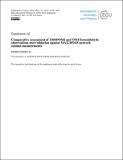Por favor, use este identificador para citar o enlazar a este item:
http://hdl.handle.net/10261/254205COMPARTIR / EXPORTAR:
 SHARE SHARE
 CORE
BASE CORE
BASE
|
|
| Visualizar otros formatos: MARC | Dublin Core | RDF | ORE | MODS | METS | DIDL | DATACITE | |

| Título: | Comparative assessment of TROPOMI and OMI formaldehyde observations and validation against MAX-DOAS network column measurements |
Autor: | Smedt, Isabelle de; Pinardi, Gaia; Vigouroux, Corinne; Compernolle, Steven; Bais, Alkis; Benavent, Nuria CSIC ORCID; Boersma, Folkert; Chan, K.L.; Donner, Sebastian; Eichmann, K.U.; Hedelt, Pascal; Hendrick, Francois; Irie, Hitoshi; Kumar, Vinod; Lambert, J. C.; Langerock, Bavo; Lerot, C.; Liu, Cheng; Loyola, Diego; Piters, Ankie; Richter, Andreas; Rivera Cárdenas, Claudia; Romahn, Fabian; Ryan, Robert G.; Sinha, V.; Theys, Nicolas; Vlietinck, Jonas; Wagner, Thomas; Wang, Teng; Yu, Huan; Van Roozendael, M. | Fecha de publicación: | 23-ago-2021 | Editor: | European Geophysical Society | Citación: | Atmospheric Chemistry and Physics 21: 12561-12593 (2021) | Resumen: | The TROPOspheric Monitoring Instrument(TROPOMI), launched in October 2017 on board the Sentinel-5 Precursor (S5P) satellite, monitors the composition of the Earth's atmosphere at an unprecedented horizontal resolution as fine as 3.5×5.5 km2. This paper assesses the performances of the TROPOMI formaldehyde(HCHO) operational product compared to its predecessor, the OMI (Ozone Monitoring Instrument) HCHO QA4ECV product, at different spatial and temporal scales. The parallel development of the two algorithms favoured the consistency of the products, which facilitates the production of long-term combined time series. The main difference between the two satellite products is related to the use of different cloud algorithms, leading to a positive bias of OMI compared to TROPOMI of up to 30% in tropical regions. We show that after switching off the explicit correction for cloud effects, the two datasets come into an excellent agreement. For medium to large HCHO vertical columns(larger than 5×1015 molec. cm-2) the median bias between OMI and TROPOMI HCHO columns is not larger than 10% (<0.4×1015 molec. cm-2). For lower columns, OMI observations present a remaining positive bias of about 20% (<0.8×1015 molec. cm-2) compared to TROPOMI in midlatitude regions. Here, we also use a global network of 18 MAX-DOAS (multi-axis differential optical absorption spectroscopy) instruments to validate both satellite sensors for a large range of HCHO columns. This work complements the study by Vigouroux et al. (2020), where a global FTIR(Fourier transform infrared) network is used to validate the TROPOMI HCHO operational product. Consistent with the FTIR validation study, we find that for elevated HCHO columns, TROPOMI data are systematically low (-25% for HCHO columns larger than 8 × 1015 molec. cm-2), while no significant bias is found for medium-range column values. We further show that OMI and TROPOMI data present equivalent biases for large HCHO levels. However, TROPOMI significantly improves the precision of the HCHO observations at short temporal scales and for low HCHO columns. We show that compared to OMI, the precision of the TROPOMI HCHO columns is improved by 25% for individual pixels and by up to a factor of 3 when considering daily averages in 20 km radius circles. The validation precision obtained with daily TROPOMI observations is comparable to the one obtained with monthly OMI observations. To illustrate the improved performances of TROPOMI in capturing weak HCHO signals, we present clear detection of HCHO column enhancements related to shipping emissions in the Indian Ocean. This is achieved by averaging data over a much shorter period (3 months) than required with previous sensors (5 years) and opens new perspectives to study shipping emissions of VOCs (volatile organic compounds) and related atmospheric chemical interactions. | Descripción: | 33 pags., 23 figs., 5 tabs. | Versión del editor: | http://dx.doi.org/10.5194/acp-21-12561-2021 | URI: | http://hdl.handle.net/10261/254205 | DOI: | 10.5194/acp-21-12561-2021 | Identificadores: | doi: 10.5194/acp-21-12561-2021 issn: 1680-7324 |
| Aparece en las colecciones: | (IQF) Artículos |
Ficheros en este ítem:
| Fichero | Descripción | Tamaño | Formato | |
|---|---|---|---|---|
| TROPOMI and OMI formaldehyde.pdf | 34,64 MB | Adobe PDF |  Visualizar/Abrir | |
| Supplement.pdf | 1,66 MB | Adobe PDF |  Visualizar/Abrir |
CORE Recommender
SCOPUSTM
Citations
56
checked on 20-abr-2024
WEB OF SCIENCETM
Citations
47
checked on 27-feb-2024
Page view(s)
83
checked on 23-abr-2024
Download(s)
42
checked on 23-abr-2024
Google ScholarTM
Check
Altmetric
Altmetric
Este item está licenciado bajo una Licencia Creative Commons

